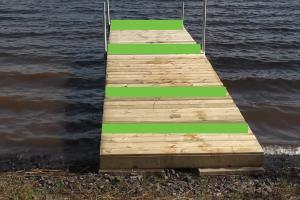Ultimate Guide to Building Your Own Dock: Step-by-Step Instructions

-
Quick Links:
- 1. Introduction
- 2. Planning Your Dock
- 3. Choosing the Right Materials
- 4. Dock Design Options
- 5. Step-by-Step Guide to Building Your Dock
- 6. Case Studies of Successful Docks
- 7. Maintenance Tips for Your Dock
- 8. Expert Insights on Dock Building
- 9. Common Mistakes to Avoid
- 10. FAQs
1. Introduction
Building a dock can be an exciting and rewarding project for any waterfront property owner. Not only does it enhance your outdoor space, but it also provides a functional area for boating, fishing, or simply relaxing by the water. This comprehensive guide will walk you through the entire process of building your own dock, from planning to execution.
2. Planning Your Dock
Before diving into construction, proper planning is crucial. Here are some key considerations:
- Location: Choose a location that is accessible, with stable ground and a suitable depth of water.
- Size: Determine how large you want your dock to be based on its intended use.
- Local Regulations: Check local zoning laws and building codes; some areas may require permits.
- Environmental Impact: Consider the ecological effects of your dock on local waterways.
3. Choosing the Right Materials
The materials you choose will significantly affect the durability and aesthetics of your dock. Common materials include:
- Pressure-Treated Wood: Affordable and widely used, but requires regular maintenance.
- Composite Materials: Durable and low-maintenance, these options resist rot and insects.
- Aluminum: Lightweight and corrosion-resistant, ideal for floating docks.
- Concrete: Extremely durable, but more challenging to install.
4. Dock Design Options
There are several designs to consider when building your dock:
- Floating Docks: Ideal for fluctuating water levels.
- Fixed Docks: Best for stable water conditions.
- Combination Docks: A mix of fixed and floating designs for versatility.
5. Step-by-Step Guide to Building Your Dock
Step 1: Gather Your Tools and Materials
Before starting construction, ensure you have the following tools and materials:
- Tools: Circular saw, drill, level, hammer, measuring tape, and safety gear.
- Materials: Your chosen decking material, pilings, brackets, and fasteners.
Step 2: Mark the Dock Layout
Use stakes and string to outline the shape of your dock on the ground, ensuring it's straight and square.
Step 3: Install Pilings
Pilings are essential for a sturdy dock. Use a post driver or auger to place them into the ground or waterbed.
Step 4: Build the Frame
Create a frame using your chosen materials, ensuring it is level and securely fastened.
Step 5: Attach the Decking
Install the decking material, leaving small gaps for drainage and expansion.
Step 6: Add Finishing Touches
Install safety features like railings and lighting, and consider adding a ladder for accessibility.
6. Case Studies of Successful Docks
Here are a few examples of successful dock projects:
- Lakefront Retreat: A family built a floating dock in a serene lake to enhance their vacation experience.
- Commercial Marina: A business owner constructed a fixed dock to accommodate various boats, increasing revenue.
- Residential Upgrade: A homeowner transformed a small backyard into a beautiful dock for fishing.
7. Maintenance Tips for Your Dock
Regular maintenance will prolong the life of your dock. Here are tips to consider:
- Inspect the dock for damage annually.
- Clean debris and algae buildup regularly.
- Apply sealant to wooden surfaces every few years.
8. Expert Insights on Dock Building
We consulted experts to gather some insights:
"Choosing the right materials is key to a long-lasting dock. Always consider your local climate and water conditions." – John Smith, Dock Construction Specialist
9. Common Mistakes to Avoid
Here are some pitfalls to watch out for:
- Not checking local regulations before starting.
- Using inadequate materials for the specific environment.
- Neglecting proper maintenance after construction.
10. FAQs
What permits do I need to build a dock?
Permits vary by location, so check with your local building department.
How long does it take to build a dock?
The timeline can range from a few days to several weeks, depending on the complexity of the design.
Can I build a dock myself?
Yes, many people build their own docks, but consider hiring a professional for complex designs.
What is the best material for a dock?
It depends on your needs; composite materials are durable and require low maintenance.
How do I maintain a wooden dock?
Inspect regularly, clean off algae, and apply sealant as necessary.
Is a floating dock better than a fixed dock?
Floating docks are better for areas with fluctuating water levels, while fixed docks work well in stable conditions.
What tools do I need for building a dock?
Essential tools include a circular saw, drill, measuring tape, level, and safety gear.
How much does it cost to build a dock?
Costs can range from a few hundred to several thousand dollars, depending on size and materials.
Can I add features like lights and seating to my dock?
Yes, adding features like lighting and seating can enhance the functionality of your dock.
What should I consider when designing my dock?
Consider your intended use, local regulations, and environmental impact.
Are there any environmentally friendly options for docks?
Yes, consider using sustainable materials and designs that minimize environmental impact.